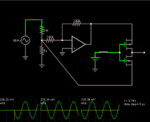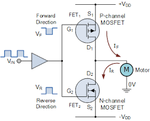mheruian
Junior Member level 3
Hi i'm just a starting out hobbyist who knows how to use arduino in switching purposes but there is this switching scheme i want to perform but didn't work out the way i thought it was when i simulate it. Though given i have references provided by guys here told me to follow. I'm not much knowledgeable about the different matters about transistors. All i know about them is these are like switches on saturation.

above is the circuit i simulated using this site https://www.falstad.com/circuit/
it's a circuit where i want the hi-ac voltage be turned into small value and will act as a small signal analog for input testing. Originally, it doesn't have those complementary mosfets so basically the outputs will be from the two end points where the difference is their phasing only, one is reverse using the inverting op amp configuration (w/c i learn at youtube tutorial only).
now i want to create a one end output only where it'll either output the non-reversed phase or reversed phase via 1 switching only (either coming from spdt switch, another transistor, ICs like DMX, i/o expanders, microcontroller, etc.) i even wanted to put a pull down diode and resistor setup on the gates of the complementary mosfets to give state indicator. But this setup doesn't work the way i think because every time i open the switch, it doesn't reverse the phasing - it doesn't even have output (0 volts).
in short, i want to create a dpst (double pole single throw) digital switch for my two AC outputs having 180 degree phase difference, i don't want to use ssr or relays. :'( i hope you can help me.
my references are below:



above is the circuit i simulated using this site https://www.falstad.com/circuit/
it's a circuit where i want the hi-ac voltage be turned into small value and will act as a small signal analog for input testing. Originally, it doesn't have those complementary mosfets so basically the outputs will be from the two end points where the difference is their phasing only, one is reverse using the inverting op amp configuration (w/c i learn at youtube tutorial only).
now i want to create a one end output only where it'll either output the non-reversed phase or reversed phase via 1 switching only (either coming from spdt switch, another transistor, ICs like DMX, i/o expanders, microcontroller, etc.) i even wanted to put a pull down diode and resistor setup on the gates of the complementary mosfets to give state indicator. But this setup doesn't work the way i think because every time i open the switch, it doesn't reverse the phasing - it doesn't even have output (0 volts).
in short, i want to create a dpst (double pole single throw) digital switch for my two AC outputs having 180 degree phase difference, i don't want to use ssr or relays. :'( i hope you can help me.
my references are below:

